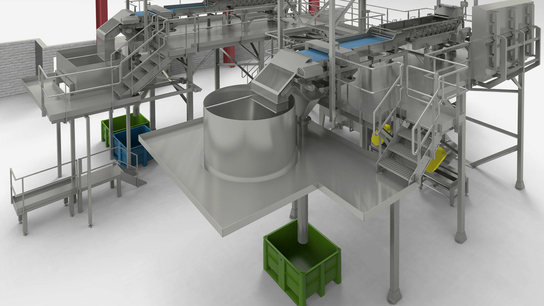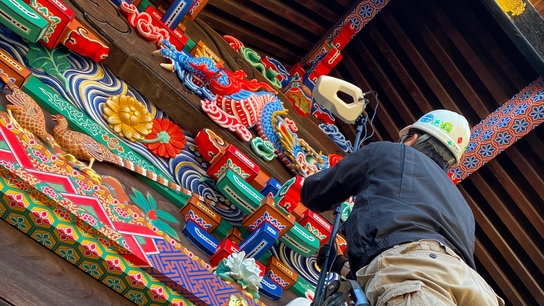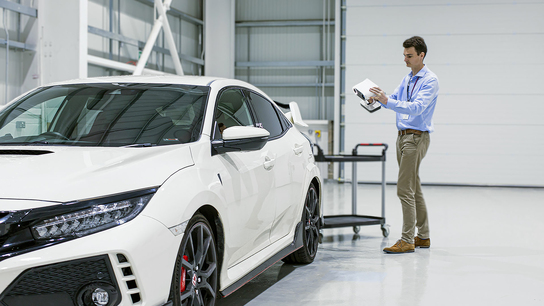Illumaesthetic kicks car customization up a gear with Artec Leo 3D scanning
Challenge: Illumaesthetic was seeking a way of modernizing the traditionally labor-intensive and often inaccurate measurement techniques behind its aftermarket automotive prototyping services.
Solution: Artec Leo, Artec Eva, Artec Studio, Geomagic
Result: Switching from manual hand carving and molding to 3D scanning and printing has improved the accuracy, speed, and overall cost efficiency of the company’s design and prototyping processes.
Why Artec 3D? Now that the firm has upgraded from Artec Eva to the wireless, next-generation Artec Leo, it can scan even faster, pick up more detailed data, and capture with true freedom.

Illumaesthetic founder Adam Bao using Artec Leo to 3D scan a Subaru Impreza STI
Dating back to the 1930s, car modification or ‘modding’ has long been a popular pastime among automotive enthusiasts, and it’s by no means a dying art.
Fans of modern franchises like Fast and Furious and Need for Speed will no doubt be familiar with popular modded cars like the Toyota Supra and Ford Mustang. Modding is still so popular that even Pimp My Ride, the classic TV show in which cars are restored and fitted with whacky mods, is set for a comeback after a 16-year hiatus.
For automotive engineering consultancy firms such as Illumaesthetic, this appetite for modding content continues to be reflected in demand for its services. In an effort to meet this demand, it has now revolutionized its design process – with the help of Artec 3D scanning.
Modding at Illumaesthetic
In the automotive customization industry that thrives on a mixture of precision and creativity, it could be argued that Illumaesthetic is a beacon of innovation. Guided by founder Adam Bao, the company seeks to merge art with automotive functionality, reshaping the future of car design piece by piece with each custom body kit they create.
In practice, Ilumaesthetic offers end-to-end automotive consultancy services for those seeking to upgrade their car’s aesthetics and performance. On any given day, this could see its team go from reverse engineering tail lights to designing and prototyping a custom hood scoop.

Illumaesthetic software engineer Nikita Rushmanov scanning a Toyota Supra
To date, the firm’s engineers have developed aftermarket parts for everything from modding favorites like the Nissan Skyline, to a BMW 3-Series coupe. But until recently, they still faced significant challenges when it came to realizing their creative visions.
Traditional modification design methods are labor-intensive, relying heavily on manual measurements, physical molds, and a considerable amount of hand carving.
This makes the process time-consuming and prone to error, leading to frequent and costly iterations, which use up valuable materials. Inexact measurements also compromise fit and finish, while making the creation of properly mirrored parts extremely difficult.
Changing gears with Artec Leo
In pursuit of a more efficient measurement solution, Bao’s team has turned to Artec 3D scanning. Having initially borrowed an Artec Eva and found they could rapidly digitize entire cars, they’ve now made this workflow even faster with the AI-powered Artec Leo.
“[Before Leo], I’d have to masking tape the crap out of the car. With Leo, at the absolute worst, I just put two tape strips on the door, and draw a big X on the hood and roof,” explained Bao. “It also depends on color, but Leo is much faster. On average, a complete scan would take Eva two hours, whereas with Leo I’d only need 15-30 minutes.”
While “hobby-grade scanners seem to be getting better,” he adds that “none of them are as fast or portable as Artec Leo,” which are “huge things” for being first to market. Since getting hold of two Leos from Artec Gold-certified Partner Indicate Technologies, Bao has found the latter to be particularly important when it comes to capturing vehicles’ interiors.

The Artec Leo 3D scanners Illumaesthetic has been using for two years
“When you have cables under the car you constantly double back on yourself,” added Bao. “I wouldn’t say it stops us from being able to do it, but it is incredibly annoying, especially with interior stuff. With Artec Leo, that’s not a problem.”
According to Bao, Artec Leo’s battery life doesn’t get spoken about enough either. Being able to capture several cars on one charge has also been a game-changer for his firm. Before, he and his team were limited by their laptop’s battery, but now that’s no longer a restraint as they can send scans to a server for processing, completely wirelessly.
“One of the biggest things with Leo is how long its battery lasts. It boggles my mind! I have four extra battery slots and just think: ‘Why would you ever need more than this?’”
Renovating a rally legend
Beyond speed and flexibility, Artec Leo’s advanced functionalities, such as its ability to capture lifelike, high-resolution textures in HD Mode, has also revolutionized Illumaesthetic’s design approach.
Gone are the days of laborious manual measurements, molds, and repetitions. Smart data capture has cultivated an environment ripe for creativity and innovation across the firm. Bao’s team now regularly scans in full 1:1 HD Mode, generating up to 600 GB of data on a single project, all in effort to maximize accuracy.
Since adopting Leo, one of their more impressive projects has seen them customize a classic Subaru Impreza STI. With Artec 3D scanning, they’ve been able to precisely model the original bumper and all its mounting points to ensure a custom version would fit.

Remodeled bumper made to clear piping, ready for 3D printing
Inspired by Subaru’s rich rally pedigree, the revamped part features integrated brake ducts, fog light covers, canards, splitter supports, and tow hook mounts. Not just a testament to Leo’s precision, the modification is a masterstroke in automotive aesthetics, blending seamlessly with the rest of the car’s now iconic design.
Artec Studio has also become central to Illumaesthetic’s workflow. Once its engineers have finished scanning a vehicle, they sometimes export to 3D design platforms like Geomagic, but they can complete most tasks with Artec Studio’s built-in tools.
“Let’s say I was dealing with a control arm,” explained Illumaesthetic software engineer Nikita Rushmanov. “I would just need to extract three geometric points for it, where it mounts to the chassis and matches up to the knuckle. In reverse engineering, [Artec Studio] can’t do absolutely everything, but it has come a long way. I really enjoy using it!”
“Artec Studio’s approach is quite innovative as it lets you solve all the design constraints at once, then refit. It saves so much time.”
Blazing a trail in automotive
Promisingly for Bao and his team, Leo has also improved their client communication. As they’re now able to generate clear, detailed 3D data in minutes, they can share intricate, accurate copies of design plans with clientele at any given moment.
This makes it easy for clients to become part of the design process and guarantees their satisfaction with the final results. In some cases, Illumaesthetic will even export digitized, fully textured copies of cars to customers to give them a realistic feel of how they’ll look.

The team’s final custom version of the Subaru Impreza STI
As the company continues to blaze a trail at the intersection of advanced technology and auto customization, Rushmanov has begun a groundbreaking project of his own. Working with sister firm BD Engineering, he’s developing innovative products for his car, a Toyota Supra, which are set to transform it into a high-speed drifting machine.
With projects like this, the Illumaesthetic crew demonstrate the boundless potential of technology to revolutionize traditional industries. In a world where precision meets creativity, Illumaesthetic isn’t following anyone else’s path – they’re blazing their own.
“Every day, we’re seeing the transformative changes that Artec Leo has brought to our shop,” concluded Bao. “With it, we’re exploring new design avenues. It’s an amazing member of our team now, and we've been offered to trial plenty of new scanners – we politely decline.”
Scanners behind the story
Try out the world's leading handheld 3D scanners.





